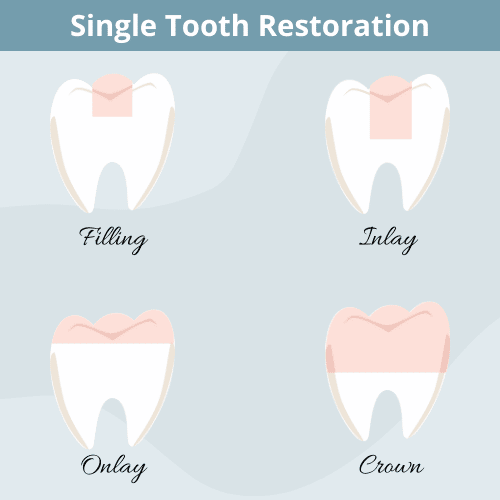Your dentist informing you of a cavity during your dental check-up is a patient’s nightmare. Cavities typically carry images of large drills and painful filling procedures. But do you actually know what’s going on inside your mouth when your dentist is treating a cavity? Dental professionals are skilled experts in making sure your teeth return to peak healthiness after a cavity. Here’s what is happening when your dentist is doing their job at a cavity filling appointment.

Fillings
If you’ve had a cavity filled in a single visit before, it was probably a filling. Especially if your dentist caught the cavity early and filled it when it was small and in the early stages of decay. Fillings are most like inlays but are not customized in a lab for the patient.
A filling is made from amalgam or composite and fills the space drilled out from the cavity directly. This process is quick and is a single appointment restoration method.
Inlays
Inlays are used for cavities that are slightly larger than those that can be accurately filled by a single-appointment filling. An inlay is a restoration that fits within the cusps of a tooth. The cusp of the tooth is the rounded top of the tooth moving towards the outer sides. It is made outside of the mouth as opposed to a filling that is made inside the mouth. It may be made of porcelain or metal, in a lab or at the office with a CEREC machine. A CEREC (Chairside Economical Restoration of Esthetic Ceramics) machine is used to streamline the lab-made restoration tool process in your dentist’s office. An inlay is bonded into the tooth by the dentist at a later appointment.
A filling has the potential to contract as it ages, leaving a small space between your natural tooth structure and the filling material. Inlays do not pose this issue and remain flush with the natural tooth for life. This means with an inlay there is little to no chance of restoration failure.
Onlays
If your dentist determines that your cavity is at a later stage or is too large to be effectively treated with an inlay, they may choose to use an onlay as the method of restoration. An onlay is a restoration made outside the mouth that replaces a cusp or cusps of a tooth. Onlays reach past the “inside” area of the tooth, to the “outside” of the tooth’s surface.
Onlays are more extensive than an inlay because it covers one or more cusps. Onlays are sometimes called partial crowns. This is a more conservative or tooth structure-saving restoration than a full crown. An onlay can be made of porcelain or metal and is also created by your dentist on a CEREC machine or in a dental lab.
These are considered “indirect” fillings because they are fabricated outside the mouth, generally at a dental laboratory, and then bonded to the tooth by the dentist.
Crowns
Crowns are what many people picture when they feel fear of the dentist or their restoration appointment. Crowns are made of metal and are the shiny, whole tooth covering restoration you may recognize from photos.
Of the four single tooth restoration methods discussed in this post, a crown is the most aggressive method. A crown will cover the entire surface of the tooth and go down to the gum in their coverage. Dental crowns will be suggested if your cavity has resulted in decay across a large portion of the tooth.